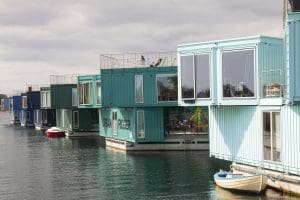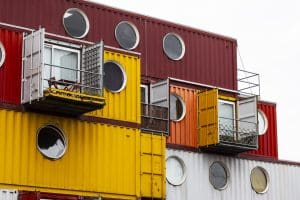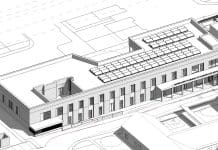Discover how innovative architects are transforming recycled materials into stunning sustainable structures, revealing a world of design possibilities waiting to be explored
Sustainable structures increasingly use recycled materials to enhance environmental responsibility while maintaining aesthetic appeal. Significant examples include Urban Rigger in Copenhagen, which repurposes shipping containers for housing, and Collage House in Mumbai, showcasing locally sourced recycled elements.
Argentina’s Capilla San Bernado features reclaimed bricks that reflect community engagement, while London’s Container City 2 demonstrates modular construction using construction waste. Other remarkable projects, such as Façade House in Rotterdam and the Ceramic Brick House in Vietnam, also highlight innovative practices.
These examples illustrate the potential of recycled materials in architecture, providing insights into sustainable design practices that benefit both environment and community.
Overview of sustainable architecture
Sustainable architecture, as a response to growing environmental concerns, aims to minimise ecological impact through the thoughtful use of eco-friendly materials and innovative design principles.
An essential element of this approach is incorporating recycled materials, which considerably reduce carbon footprints and conserve natural resources in construction. By using salvaged wood, metal, and even recycled plastics and concrete, architects can create buildings that are not only environmentally responsible but also visually appealing.
Moreover, sustainable architecture emphasises energy-efficient designs that enhance natural ventilation and utilise renewable resources. These designs are often complemented by waste reduction strategies, further contributing to a building’s overall sustainability. Community involvement plays a significant role in this process, fostering local engagement and education about the importance of sustainability in architecture.
The economic benefits of sustainable architecture are also remarkable; cost savings in materials and long-term energy efficiency can lead to lower operating costs. Ultimately, sustainable architecture represents a holistic approach that integrates ecological responsibility, aesthetic considerations, and community participation, proving that the use of recycled materials can lead to innovative and functional design solutions.
Urban Rigger, Copenhagen
Urban Rigger in Copenhagen exemplifies the innovative potential of sustainable architecture through its creative use of repurposed shipping containers. This student housing project not only addresses the pressing need for affordable accommodations but also showcases how recycled materials can redefine modern architecture.

The Urban Rigger project features:
- Multiple stacked containers form 380 student accommodations, effectively utilising an otherwise neglected waterway.
- Each unit incorporates solar panels and a rainwater collection system, considerably minimising its environmental footprint.
- The design harmonises functional living spaces with a contemporary aesthetic, demonstrating that sustainability can be visually engaging.
Collage House, Mumbai
How can innovative design and sustainability coexist harmoniously in urban settings? The Collage House in Mumbai exemplifies this synergy through its creative use of locally sourced recycled materials. This eco-friendly architecture showcases a commitment to sustainability by integrating a variety of textures and colours derived from reclaimed elements, transforming them into a cohesive and visually striking home.
The design of the Collage House emphasises large open spaces and strategically placed openings, enhancing natural ventilation and daylighting. Such features considerably reduce reliance on artificial lighting and cooling, thereby minimising energy consumption. In addition, the project actively supports the local economy by utilising materials and labour from the surrounding community, fostering a sense of ownership and pride among residents.
Capilla San Bernado, Argentina
The Capilla San Bernado in Argentina exemplifies the harmonious integration of innovative design and sustainability within a compact footprint. Built on a modest 92m² area, this chapel showcases how recycled materials can transform community spaces while promoting environmental responsibility. The design emphasises the importance of context, seamlessly blending with the surrounding grove.
Key features of Capilla San Bernado include:
- The use of salvaged bricks illustrates a commitment to environmentally friendly building practices.
- Serving as a crucial space for local residents, the chapel fosters social interaction and strengthens community bonds.
- Innovative architectural solutions demonstrate the potential of limited resources to create functional and appealing structures.
- The incorporation of recycled materials not only reduces waste but also reflects a broader commitment to sustainability.
Container City 2, London
Covering an area of 8,208 square meters, this five-story workspace showcases how recycled materials can be effectively integrated into modern construction. Approximately 80% of the materials utilised in Container City 2 are sourced from construction waste, greatly minimising its environmental footprint.

The project exemplifies the potential of modular construction techniques, allowing for flexibility and adaptability in urban settings. By creatively repurposing shipping containers, the design transforms what would otherwise be discarded into functional office spaces, reflecting a commitment to ecological responsibility. This development serves as a model for sustainable architecture, demonstrating that the use of recycled materials can address both environmental challenges and urban needs.
Container City 2 not only highlights the viability of using shipping containers in architectural design but also encourages broader discussions about the future of construction practices. As cities continue to grow, projects like this provide a compelling blueprint for integrating sustainability into urban development, ensuring that the building sector moves towards a more responsible and innovative future.
Façade House in Rotterdam
While many architectural projects aim for sustainability, the Façade House in Rotterdam stands out for its innovative use of recycled waste materials in its exterior design. This striking building showcases how environmentally conscious architecture can redefine urban aesthetics while addressing waste management challenges.
Key features of the Façade House include:
- Constructed from 15 tons of industrial waste, these bricks exemplify the transformation of discarded materials into a functional façade.
- The design incorporates principles that enhance thermal performance and air quality, contributing to a healthier living environment.
- By utilising recycled materials, the Façade House raises awareness about sustainability in construction, encouraging community engagement.
Ceramic Brick House, Vietnam
Building on the principles demonstrated by the Façade House in Rotterdam, the Ceramic Brick House in Vietnam exemplifies innovative approaches to sustainability through its unique architectural features. This structure utilises ceramic bricks, which enhance natural ventilation while providing effective air filtration and heat dissipation. The double-skin façade not only improves thermal insulation but also champions sustainable practices by employing locally sourced materials.
The construction method of the Ceramic Brick House focuses on maximising energy efficiency, greatly reducing reliance on artificial heating and cooling systems. This strategy aligns with the principles of sustainable living, ensuring comfort while minimising environmental impact. By integrating biophilic design elements, the house fosters a connection between indoor and outdoor environments, enhancing the well-being of its occupants.
Wadi School, Rajkot
Wadi School in Rajkot exemplifies a commitment to sustainable architecture through its strategic use of locally sourced materials. The design emphasises the integration of recycled materials, showcasing how thoughtful construction can create environmentally friendly educational spaces.
Key features of Wadi School include:
- The primary material is gypsum sourced from the local ceramic industry, minimizing waste and reducing transportation emissions.
- Bamboo, a renewable resource, is incorporated into the structure, promoting sustainability and supporting local economies.
- The school employs natural ventilation strategies, enhancing indoor air quality while reducing energy consumption.
- Local stakeholders are involved in the construction process and material selection.













